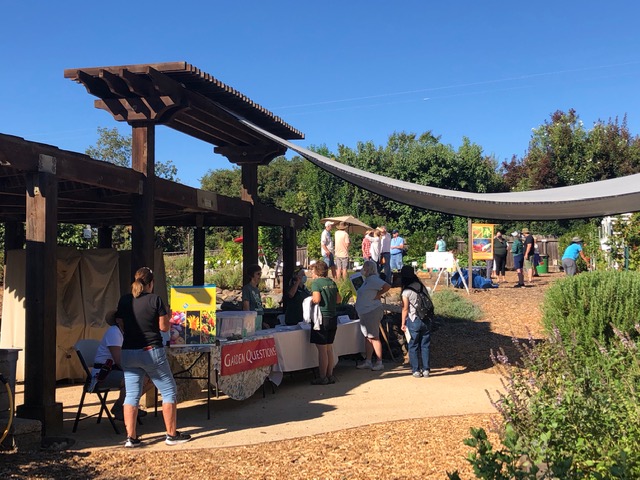
Saturday's event will be last until next year

|
|
The Fair Oaks Horticulture Center should be just as pleasant Saturday as it was
at the previous Open Garden in September, though likely cooler. (Photo:
Kathy Morrison)
|
The weather is ideal, the light is enchanting, and the season is perfect for planting. What better time to visit the Fair Oaks Horticulture Center?
The Sacramento County master gardeners will hold their final Open Garden of the year Saturday from 9 a.m. to noon, and they're ready to tackle any and all gardening questions. While you're there, pick up the 2022 Gardening Guide and Calendar. It continues to be a garden bargain at just $10.
FOHC is at 11549 Fair Oaks Blvd., next to Fair Oaks Park. No specific demonstrations or talks are planned Saturday, but there will be teams of master gardeners stationed in each area of the FOHC. There's a Gardening Questions table for more general questions, too.
Here are some ideas for visitors:
-- Composting. Learn how to make "garden gold." The project area has been moved to a new spot on the hill portion of the garden, but the information and enthusiasm are the same. Ask which bin is best for compost! There are definite opinions. And check out the worm bin, too.
-- Berries. These may be the trickiest plants to tend, after the grapevines. Cane berries and blueberries are grown at the FOHC. Ask about winter pruning!
-- Vineyard. The grapes are just about done, so ask about pruning here, too. Explore the difference between cane-pruned grapes and spur-pruned ones.
-- Herbs. Most of the herb planting areas were redone after the new Chuck Ingels Memorial Gate was installed nearby. Treat yourself to a big whiff of the lemon verbena or the various scented geraniums, and ask about overwintering herbs.
-- Vegetables. Everyone's favorite stop, the vegetable garden should be plush with the cool-weather crops planted last month and new cover crops going in. Ask about the various cover crops, and also how to keep little green worms from devouring your brassicas.
-- Orchard. The new crops should be evident on the citrus trees. Learn how to tell when to pick the fruit; it makes a difference, especially with oranges. In the rest of the orchard, see which fruit is still on the trees, and ask how they keep the birds and squirrels from eating it all.
-- Water Efficient Landscape. This is the best place to pull out a notebook and make a list of pretty fall plants that are easy on water and a delight for humans and pollinators. All the plants are labeled; ask a friendly master gardener for additional information on planting.
If you can't attend Saturday or later think of a question later, the UCCE Sacramento County master gardeners' website https://sacmg.ucanr.edu/ is loaded with gardening information. For general information on the Open Garden, go to https://sacmg.ucanr.edu/?calitem=389781
Comments
0 comments have been posted.Sacramento Digs Gardening to your inbox.
Food in My Back Yard Series
April 22: Should you stock up on fertilizer? (Yes!)
April 15: Grow culinary herbs in containers
April 8: When to plant summer vegetables
April 1: Don't be fooled by these garden myths
March 25: Fertilizer tips: How to 'feed' your vegetables for healthy growth
March 18: Time to give vegetable seedlings some more space
March 11: Ways to win the fight against weeds
March 4: Potatoes from the garden
Feb. 25: Plant a fruit tree now -- for later
Feb. 18: How to squeeze more food into less space
Feb. 11: When to plant? Consider staggering your transplants
Feb. 4: Starting in seed starting
Sites We Like
Garden Checklist for week of April 27
Once the clouds clear, get to work. Spring growth is in high gear.
* Set out tomato, pepper and eggplant transplants.
* From seed, plant beans, beets, cantaloupes, carrots, corn, cucumbers, melons, pumpkins, radishes and squash. Plant onion sets.
* In the flower garden, plant seeds for asters, cosmos, celosia, marigolds, salvia, sunflowers and zinnias. Transplant petunias, zinnias, geraniums and other summer bloomers.
* Plant perennials and dahlia tubers for summer bloom. Late April is about the last chance to plant summer bulbs, such as gladiolus and tuberous begonias.
* Transplant lettuce and cabbage seedlings.
* Weed, weed, weed! Don’t let unwanted plants go to seed.
* April is the last chance to plant citrus trees such as dwarf orange, lemon and kumquat. These trees also look good in landscaping and provide fresh fruit in winter.
* Feed citrus trees with a low dose of balanced fertilizer (such as 10-10-10) during bloom to help set fruit. Keep an eye out for ants.
* Apply slow-release fertilizer to the lawn.
* Thoroughly clean debris from the bottom of outdoor ponds or fountains.
* Start thinning fruit that's formed on apple and stone fruit trees -- you'll get larger fruit at harvest (and avoid limb breakage) if some is thinned now. The UC recommendation is to thin fruit when it is about 3/4 of an inch in diameter. Peaches and nectarines should be thinned to about 6 inches apart; smaller fruit such as plums and pluots can be about 4 inches apart. Apricots can be left at 3 inches apart. Apples and pears should be thinned to one fruit per cluster of flowers, 6 to 8 inches apart.
* Azaleas and camellias looking a little yellow? If leaves are turning yellow between the veins, give them a boost with chelated iron.
* Trim dead flowers but not leaves from spring-flowering bulbs such as daffodils and tulips. Those leaves gather energy to create next year's flowers. Also, give the bulbs a fertilizer boost after bloom.
* Pinch chrysanthemums back to 12 inches for fall flowers. Cut old stems to the ground.
* Mulch around plants to conserve moisture and control weeds.